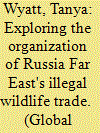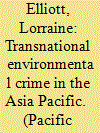| Srl | Item |
| 1 |
ID:
087466


|
|
|
|
|
| Publication |
2009.
|
| Summary/Abstract |
The Russian Federation is a source of wildlife and wildlife products that fuel the vast, and often overlooked, illegal wildlife trade that takes place around the globe. Out of the many illicit animal and plant trades, two of these black markets - the illegal fur trade and the illegal falcon trade - are used in this article to explore the organization of this illicit activity in Russia Far East. Using interviews from Russian and other wildlife trade experts, structural frameworks are established for each of these illegal wildlife markets.
|
|
|
|
|
|
|
|
|
|
|
|
|
|
|
|
| 2 |
ID:
080572


|
|
|
|
|
| Publication |
2007.
|
| Summary/Abstract |
While other forms of transnational crime in the Asia Pacific have been securitized - that is, represented by policy elites and security actors as crucial or existential threats to national and regional security - transnational environmental crime has been un(der)securitized. It warrants little mention in regional security statements or the security concerns of individual countries. Yet the consequences of activities such as illegal logging and timber smuggling, wildlife smuggling, the black market in ozone-depleting substances and dumping of other forms of hazardous wastes and chemical fit the (in)security profile applied to other forms of transnational crime. This article surveys the main forms of transnational environmental crime in the Asia Pacific and assesses the 'fit' with a 'crime as security' framework. It shows that transnational environmental crime generates the kinds of 'pernicious effects on regional stability and development, the maintenance of the rule of law and the welfare of the region's people' that the ASEAN Declaration on Transnational Crime identified as matters of serious concern. The analysis draws on securitization theory to understand the lack of a 'securitizing move' and to explain why security elites do not believe the problem warrants serious attention. The possibilities explored here include intellectual inertia, confusion about referent objects, institutional incapacity, mixed policy signals and the exclusion of environmental expertise from a closed community of security elites
|
|
|
|
|
|
|
|
|
|
|
|
|
|
|
|